
Share all Covid-related data after new research: WHO calls on China to be transparent
text_fieldsThe World Health Organization (WHO) has asked China to be transparent and to release all the information related to the investigation it conducts.
The UN health agency said this after new findings were shared on an international database used to track pathogens.
The WHO criticised China for withholding data related to samples taken at a market in Wuhan in 2020 that could have provided vital information about the Covid-19 pandemic's origins.
The Huanan market in central China's Wuhan city was the epicentre of the pandemic. From its origin there, the SARS-CoV-2 virus rapidly spread to other locations in Wuhan in late 2019 and then to the rest of the world.
‘Every piece of data relating to studying the origins of COVID-19 needs to be shared with the international community immediately. These data could have and should have been shared three years ago,’ World Health Organisation (WHO) Director-General Dr Tedros Adhanom Ghebreyesus said in Geneva on Friday.
‘We continue to call on China to be transparent in sharing data and to conduct the necessary investigations and share the results. Understanding how the pandemic began remains both a moral and scientific imperative,’ he said.
Ghebreyesus said that last Sunday, the global health agency was made aware of data published on the GISAID database in late January, and taken down again recently.
‘The data, from the Chinese Center for Disease Control and Prevention, relates to samples taken at the Huanan market in Wuhan, in 2020,’ he said.
Ghebreyesus said while the data was online, scientists from a number of countries downloaded the data and analysed it.
‘As soon as we became aware of this data, we contacted the Chinese CDC and urged them to share it with WHO and the international scientific community so it can be analysed,’ he said, adding that WHO also convened the Scientific Advisory Group for the Origins of Novel Pathogens, or SAGO, which met on Tuesday.
‘We asked researchers from the Chinese CDC and the international group of scientists to present their analyses of the data to SAGO. These data do not provide a definitive answer to the question of how the pandemic began, but every piece of data is important in moving us closer to that answer,’ he said.
In a report Thursday, the New York Times said that an international team of virus experts said they had "found genetic data from a market in Wuhan, China, linking the coronavirus with raccoon dogs for sale there."
The NYT report said that the genetic data was drawn from swabs taken from in and around the Huanan Seafood Wholesale Market starting in January 2020, ‘shortly after the Chinese authorities had shut down the market because of suspicions that it was linked to the outbreak of a new virus.’
While the animals had been cleared out from the market, researchers took swabs from the walls, floors, metal cages and carts used for transporting animal cages.
‘In samples that came back positive for the coronavirus, the international research team found genetic material belonging to animals, including large amounts that were a match for the raccoon dog,’ the report said, quoting three scientists involved in the analysis.
The report noted that after the international team came across the new data, it reached out to Chinese researchers who had uploaded the files with an offer to collaborate. However, after that, the sequences disappeared from GISAID.
Globally, there have been more than 760,360,900 confirmed cases of COVID-19, including over 6,873,400 deaths, according to the World Health Organisation.
WHO said that three years later, while there are almost 7 million reported deaths from COVID-19, ‘we know that the actual number of deaths is much higher.’
Ghebreyesus expressed confidence that this year ‘we will be able to say that COVID-19 is over as a public health emergency of international concern.’
He however noted that ‘we are not there yet’ given that last week, there were still more than five thousand reported deaths from COVID-19.
‘That's five thousand too many for a disease that can be prevented and treated. Even as we become increasingly hopeful about the end of the pandemic, the question of how it began remains unanswered,’ he said.
‘We have a duty to ourselves to end this pandemic as soon as possible. We have a duty to those we have lost to find out how it started,’ he said.
The NYT report said that the ‘jumbling together’ of genetic material from the virus and the animal does not prove that a raccoon dog itself was infected.
‘And even if a raccoon dog had been infected, it would not be clear that the animal had spread the virus to people. Another animal could have passed the virus to people, or someone infected with the virus could have spread the virus to a raccoon dog,’ the report said.
‘But the analysis did establish that raccoon dogs - fluffy animals that are related to foxes and are known to be able to transmit the coronavirus - deposited genetic signatures in the same place where genetic material from the virus was left,’ according to the scientists.
They noted that the evidence was "consistent" with a scenario in which the virus spilled into humans from a wild animal.
The new evidence comes weeks after a new intelligence assessment from the US Department of Energy pointed out that an "accidental laboratory leak" in China most likely caused the pandemic.
But the genetic data from the market offers some of the most tangible evidence yet of how the virus could have spilled into people from wild animals outside a lab. It also suggests that Chinese scientists have given an incomplete account of evidence that could fill in details about how the virus was spreading at the Huanan market," the NYT report said.
With inputs from PTI























